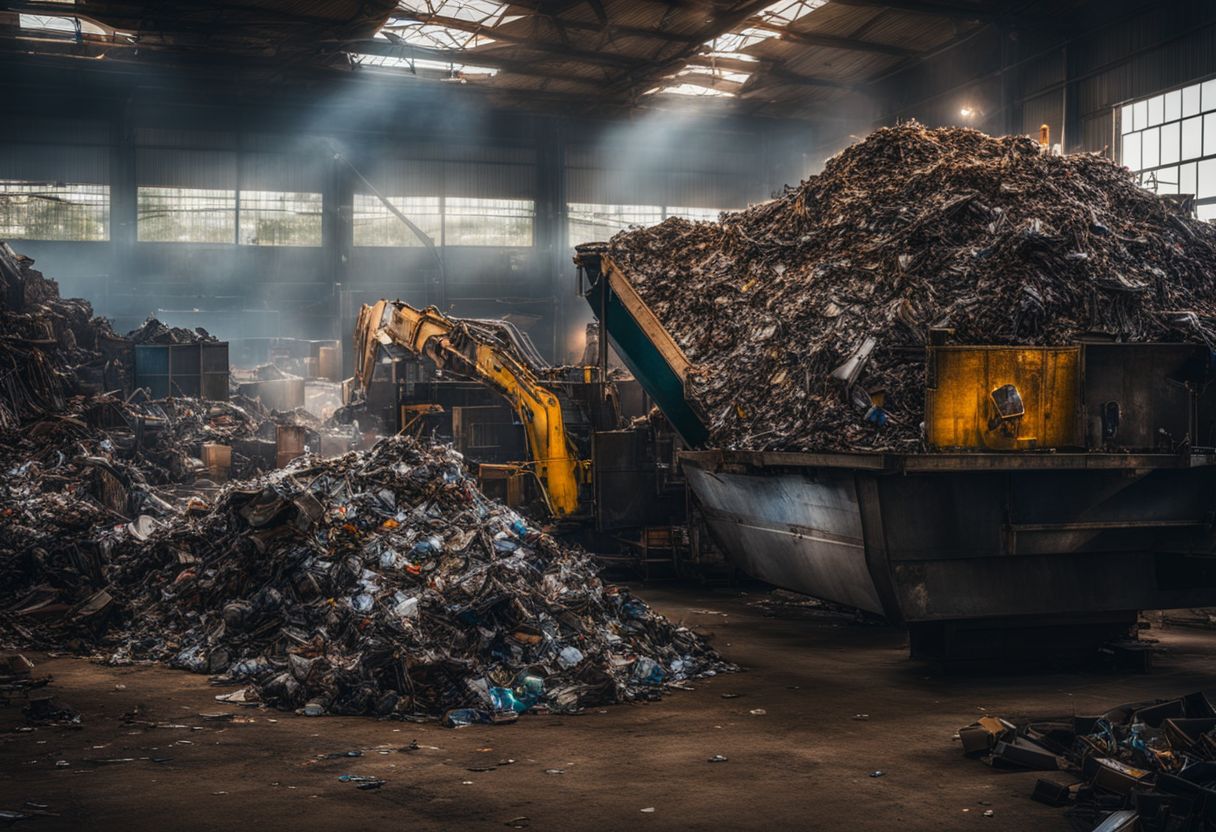Unlocking Creativity: What is Upcycling and How It Transforms the Ordinary
You know that feeling, right? The one where you look around your home and see just too many things gathering dust. It’s a sight common in homes across the globe and a symbol of our consumer culture.
Added to this is an even bigger worry – the growing problem of waste endangering our planet. But what if I told you there’s an innovative solution to both these problems? Enter upcycling – a creative method that breathes new life into old items while directly combating the waste issue.
Come with me as we explore this world of upcycling: understanding its potential benefits for our environment, discovering inspiring examples, and learning how each of us can play a part in this transformational movement for a more sustainable future!
Key Takeaways
- Upcycling is the process of turning old items into something new and better.
- It is different from recycling and downcycling because it adds value and quality to repurposed materials.
- Upcycling benefits the environment by reducing the extraction of natural resources, minimizing landfill waste, and decreasing carbon emissions.
- Examples of upcycling can be seen in art, music, industry, clothing, and even food.
What is Upcycling??

Upcycling is the process of transforming waste materials or unwanted products into new items that have a higher quality or artistic value.
Definition and simple explanation
Upcycling is turning old, unused items into something new and better. It’s like magic! I take stuff that no one wants and give it a new life. This could be an old chair turned into a flower pot or an empty soda can made to look like a shiny blue bird.
Upcycling is all about creativity. While recycling breaks things down, upcycling brings value back up!
Differences between upcycling, recycling, and downcycling
Understanding the differences between upcycling, recycling, and downcycling is essential in recognizing the specific contributions each process makes toward environmental sustainability. Let’s delve into a comparison of these three processes.
| Process | Definition | Resulting Product |
|---|---|---|
| Upcycling | Upcycling is a creative process that repurposes waste materials or unwanted products into new items with a higher quality or value. | Upcycled products are often unique and of superior quality, lending them more value than the original items. |
| Recycling | Recycling involves collecting and processing materials that would be considered waste to form new products, which can either be of the same quality or of reduced quality. | The products resulting from recycling can vary in quality, depending on the process used and the original material. Sometimes, the quality may be lower than the original product due to degradation of the material. |
| Downcycling | Downcycling, on the other hand, involves transforming waste materials into new items, but these items are usually of lower quality or value compared to the original materials. | Downcycled items are typically less durable and valuable than the original items. They are also often more difficult to recycle or upcycle in the future. |
While all these processes contribute to waste reduction and sustainability, upcycling stands out for its ability to add value and quality to repurposed materials.
Benefits of Upcycling for the Environment

Upcycling offers several environmental benefits, such as reducing the extraction of natural resources, minimizing landfill waste, and decreasing carbon emissions.
Reduces extraction of natural resources
Upcycling is good for the earth. It cuts down on taking out more natural resources. Making new things uses up a lot of our planet’s gifts like water and metals. Upcycling saves these gifts because old items get a new life.
We don’t need to chop down trees or dig into the earth as much to get what we want. This helps us keep our planet in tip-top shape for longer!
Minimizes landfill waste
Upcycling is an important practice that helps to minimize landfill waste. By upcycling, we can give new life to items that would otherwise end up in the trash. This means less waste going into landfills and less strain on our environment.
When we upcycle, we are finding creative ways to reuse and repurpose materials instead of discarding them. This not only reduces the amount of waste ending up in landfills but also helps us conserve resources and promote sustainability.
It’s a simple but powerful way for each of us to make a positive impact on our planet by reducing landfill waste through upcycling.
Reduces carbon emissions
Upcycling is a great way to reduce carbon emissions and lower our impact on the environment. When we upcycle, we take old items and give them new life instead of throwing them away.
By doing this, we don’t need to produce as many new things, which means less energy is used and fewer greenhouse gases are emitted into the atmosphere. Recycling also helps by reducing carbon emissions, but upcycling goes a step further because it requires less energy than recycling.
So by upcycling, we can play a part in fighting climate change and creating a greener future for all.
To put it simply, when we upcycle, we’re not only saving resources but also reducing our carbon footprint. Instead of buying something new that needs to be made from scratch – using energy and emitting carbon dioxide – we can find creative ways to repurpose what already exists.
How Does Upcycling Help the Planet?
Upcycling helps the planet by reducing waste, conserving resources, and decreasing carbon emissions.
Specific ways in which upcycling benefits the environment
Upcycling benefits the environment in specific ways. Here are some important facts:
- Less waste: Upcycling reduces the amount of waste that ends up in landfills.
- Lower energy use: Upcycling requires less energy compared to producing new products.
- Resource conservation: By repurposing materials, upcycling helps conserve natural resources.
- Pollution reduction: Upcycling decreases the release of pollutants associated with manufacturing new items.
- Landfill diversion: Upcycling helps divert items from ending up in overflowing landfills.
- Environmental impact: Upcycling has a positive impact on the environment by reducing carbon emissions and conserving resources.
Examples of Upcycling
Upcycling can be seen in various forms of artistic expression, such as creating sculptures from discarded metal or making collages out of old magazines. It is also prevalent in the music industry, where musicians repurpose and reuse instruments or equipment to create unique sounds.
In addition, upcycling can be found in industries that transform waste materials into new products, like using recycled plastic bottles to make durable outdoor furniture. Another example is upcycled clothing, where designers give new life to old garments by transforming them into trendy and fashionable pieces.
Lastly, even food can be upcycled through techniques like composting or turning leftovers into delicious meals.
Art
Art plays a crucial role in upcycling by finding creative ways to repurpose unwanted materials. It offers a unique opportunity to take waste and transform it into something beautiful and useful.
Upcycled art contributes to the reuse of waste, helping to reduce the amount of trash that ends up in landfills or pollutes our environment. Through upcycling, artists can breathe new life into discarded materials, giving them a second chance at being appreciated and enjoyed.
Whether it’s turning old bottles into stunning sculptures or creating vibrant paintings from reclaimed wood, upcycled art showcases the power of imagination and resourcefulness in promoting sustainability and environmental conservation.
Music
Music is another area where upcycling can be found. Musicians and artists often repurpose old instruments or materials to create unique sounds and styles. For example, musicians may use unconventional objects like bottles, cans, or even old car parts as musical instruments.
This not only adds a creative element to their music but also helps reduce waste by giving new life to discarded items. Upcycled music encourages innovation and showcases the endless possibilities of reusing materials in artistic ways.
It’s a great way for musicians to express their creativity while promoting sustainability at the same time.
Industry
The industry plays a vital role in the practice of upcycling. Many businesses and manufacturers are embracing upcycling as a way to reduce waste and environmental impact. For example, instead of using new raw materials, companies can repurpose discarded items or materials to create new products.
This not only reduces the demand for extraction of natural resources but also decreases the amount of waste ending up in landfills. Upcycling in industries helps promote sustainability and resource conservation while contributing to a more circular economy.
It is an innovative approach that benefits both the environment and businesses by encouraging sustainable practices and eco-friendly production methods.
Clothes
In the world of upcycling, clothes play a significant role. Upcycling old clothing is a fantastic way to reduce waste and promote sustainability in the fashion industry. Instead of throwing away or recycling old garments, upcycling involves reusing them in creative ways.
Some examples include turning an old shirt into a trendy tote bag or transforming jeans into stylish shorts. By repurposing clothing, we celebrate artisanal work and craftsmanship while giving new life to items that might otherwise end up in landfills.
This process also allows for creativity and individuality in fashion, as each piece becomes unique and personalized. Additionally, upcycling has the potential to revolutionize the way fashion is produced, shifting away from fast fashion towards more sustainable practices that promote ethical and eco-friendly choices for consumers.
Food
Food upcycling is a way to reduce food waste and create delicious products from ingredients that might have otherwise been thrown away. Upcycled foods are made using unmarketable ingredients like imperfect produce or food scraps.
By repurposing these ingredients, we can help minimize food waste and make use of resources that would have otherwise gone to waste. Some examples of upcycled foods include jams made with imperfect fruits or snacks made from leftover banana bits.
It’s a sustainable approach that allows us to make the most out of our food resources while also reducing our environmental impact.
How to Upcycle
To upcycle, you can start by shopping from businesses that upcycle or giving old items a new life through creative repurposing. You can also explore potential technologies that help transform waste into new and useful products.
Shopping from businesses that upcycle
When we shop from businesses that upcycle, we are actively supporting artisans and old school craftsmanship. These businesses take materials that would otherwise be discarded and repurpose them into new, unique products.
By choosing to buy upcycled items, we contribute to the circular and sustainable economy, where waste is minimized and resources are preserved. This ecofriendly shopping approach allows us to participate in reducing waste and promoting sustainability in our daily lives.
Giving old items a new life
I love the idea of giving old items a new life through upcycling. It’s a great way to be creative and make something unique. Plus, it helps reduce waste and saves resources. Here are some ways you can give old items a new life:
- Turn an old t-shirt into a tote bag: Cut off the sleeves and collar, sew the bottom shut, and add handles. Now you have a stylish bag for groceries or everyday use.
- Repurpose glass jars: Clean out empty jars and use them as storage containers for spices, buttons, or office supplies. You can also turn them into candle holders by adding some sand and a votive candle.
- Transform furniture: Give an old dresser or table a fresh look with a coat of paint or new hardware. You can even repurpose an old door into a unique headboard for your bed.
- Create artwork from scraps: Use leftover fabric, paper, or wood to create collages or mixed media art pieces. This is a great way to showcase your creativity while reducing waste.
- Make jewelry from broken pieces: Don’t throw away broken necklaces or earrings! Instead, repurpose the beads or charms to create new jewelry pieces that reflect your style.
Using potential technologies
When it comes to upcycling, there are exciting possibilities that can be explored using potential technologies. These technologies can help us transform waste materials into new and useful products in innovative ways.
For example, 3D printing has the potential to revolutionize upcycling by allowing us to create new items from recycled plastics or other materials. Furthermore, advancements in textile technology can enable us to turn old clothing into new fabrics or even biodegradable materials.
By embracing these potential technologies, we can further enhance the environmental and creative benefits of upcycling, making our efforts towards sustainability even more impactful for a greener future.
Upcycling Materials: What Can Be Upcycled?
Various materials can be upcycled, including plastics, clothing and textiles, aluminum, glass, and industrial waste.
Plastics
Plastics are one of the most commonly used materials in our daily lives, but they also pose a significant environmental challenge. When it comes to upcycling, plastics offer great potential for transformation.
By creatively repurposing plastic waste into new and valuable materials, we can reduce the harmful impact of discarded plastics on the environment. Additionally, innovative concepts like vitrimer technology have been developed to recycle commercial plastic materials more efficiently.
While there are challenges and considerations associated with recycling plastics, such as finding alternative materials and understanding their environmental costs and benefits, upcycling remains a promising solution to tackle plastic pollution and move towards a more sustainable future.
Clothing and textiles
Upcycling clothing and textiles is an important aspect of the upcycling movement. It involves giving new life to old garments and materials, rather than throwing them away. By upcycling, we can save resources and reduce textile waste.
Instead of buying new clothes all the time, we can transform our unused or unwanted items into something new and unique. This not only helps the environment by reducing landfill waste but also supports small local businesses that specialize in upcycled fashion.
Through upcycling, we can create pieces of clothing that are of better quality and have a longer lifespan. So instead of contributing to the fast fashion culture, let’s embrace sustainable fashion through upcycling!
Aluminum
Aluminum is a material that can be upcycled to create new and useful products. Upcycling aluminum means transforming discarded items made of aluminum into something valuable instead of throwing them away.
This helps reduce waste sent to landfills and saves resources. For example, Apple has been using recycled aluminum for more than half of its products, which is good news for the environment.
Upcycling aluminum also promotes sustainable design practices and challenges common assumptions about what can be done with discarded materials. It’s an economically beneficial and creative way to contribute to a greener future while having fun along the way!
Glass
Glass is a versatile material that can be both recycled and upcycled, making it an excellent option for reducing waste and conserving resources. When glass is recycled, it is melted down and transformed into new products like bottles or jars.
However, upcycling takes glass to the next level by repurposing it in innovative ways. For example, old glass windows can be turned into beautiful stained glass artwork or used as decorative pieces in construction projects.
Additionally, the construction industry is increasingly using repurposed materials, including recycled glass, because they are sustainable and promote resource conservation. Glass has the potential to play a significant role in creating a greener future due to its ability to be transformed into new and useful items through recycling and upcycling methods.
Industrial waste
Upcycling industrial waste is an important way to reduce the negative impact it has on the environment. By finding creative ways to reuse materials that would otherwise end up in landfills, we can minimize waste and conserve resources.
When we upcycle industrial waste, we are also supporting small local businesses and rural village industries, providing economic benefits while promoting sustainability. It’s a win-win situation for both the planet and our communities.
Upcycling and its Creative Benefits
Upcycling not only benefits the environment, but it also encourages creativity and innovation, promoting a sustainable and circular economy.
Encourages creativity and innovation
Upcycling is a great way to encourage creativity and innovation. When we upcycle, we take something old or unwanted and give it a new purpose or design. This process allows us to think outside the box and find creative solutions for reusing materials in unique ways.
By repurposing items that would otherwise be discarded, we can create one-of-a-kind products that celebrate craftsmanship and show off our individuality. Upcycling also encourages us to be resourceful and think creatively about how we can reduce waste and make the most of the things we already have.
So, if you’re looking for a fun and innovative way to contribute to sustainability, try your hand at upcycling!
Promotes a sustainable and circular economy
Upcycling plays a vital role in promoting a sustainable and circular economy. By finding new uses for old items, upcycling helps reduce waste and conserve resources. It encourages us to rethink our consumption habits and find creative ways to give new life to products that might otherwise end up in landfills.
This approach reduces the need for manufacturing new goods from virgin materials, which saves energy and lowers carbon emissions. Ultimately, upcycling promotes economic growth by supporting small businesses and rural village industries, while also benefiting the environment by reducing landfill waste and conserving natural resources.
Conclusion: The Importance of Upcycling for a Greener Future
In conclusion, upcycling is a creative and eco-friendly way to give new life to old items. It helps reduce waste, conserve resources, and minimize the impact on our environment. By embracing upcycling, we can contribute to a greener future where creativity and sustainability go hand in hand.
Let’s all do our part and make a positive difference for our planet through the power of upcycling!
Additional Resources and Ways to Get Involved
I have gathered some additional resources and ways for you to get involved in upcycling:
- Explore online platforms and communities dedicated to upcycling, such as Upcycle That and Remade in Britain. These websites provide inspiration, tutorials, and forums where you can connect with like-minded individuals.
- Attend local workshops or classes on upcycling. Many community centers and craft stores offer workshops on repurposing materials into new and useful items.
- Join a local upcycling group or organization. By joining forces with others who are passionate about upcycling, you can collaborate on projects, share ideas, and support each other’s efforts.
- Follow social media accounts that focus on upcycling. They often share tips, ideas, and success stories that can inspire your own creative projects.
- Donate your old items to organizations that specialize in upcycling. Some charities accept donations of clothing, furniture, or other items that they transform into new products to sell or distribute to those in need.
- Start your own upcycling project by repurposing something you already have at home. Look around for unused or worn-out items that can be given a new life with a little creativity and effort.
- Educate yourself about sustainable fashion and consider supporting brands that prioritize upcycled materials in their production processes.
- Seek out local businesses that embrace upcycling practices. Support these establishments by purchasing their upcycled products or using their services whenever possible.
- Encourage schools and educational institutions to incorporate upcycling into their curriculum. Awareness from a young age can foster a lifelong commitment to sustainability.
- Spread the word about the benefits of upcycling! Share your own experiences, knowledge, and successes with friends, family, and colleagues to inspire them to join the movement.
FAQs
1. What is upcycling?
Upcycling is the process of turning old or discarded materials into new and useful products, often with a higher value than the original materials.
2. How does upcycling benefit the environment?
Upcycling reduces waste by reusing existing materials, which helps conserve resources, reduce pollution from manufacturing, and decrease landfill waste.
3. What are some examples of upcycled products?
Examples of upcycled products include furniture made from reclaimed wood, jewelry crafted from bottle caps or broken glass, and bags created from repurposed fabric or leather.
4. Can anyone do upcycling?
Yes, anyone can engage in upcycling as it encourages creativity and resourcefulness. It’s an accessible way to contribute to environmental sustainability on an individual level.
5. Is there a difference between recycling and upcycling?
Yes, while both recycling and upcycling involve reducing waste, recycling typically involves breaking down materials into raw form for creating new items, whereas upcycling involves transforming existing items into something different with added value.







